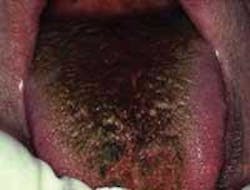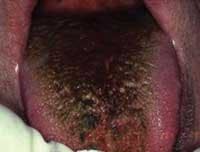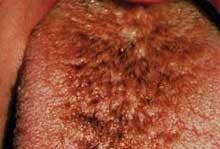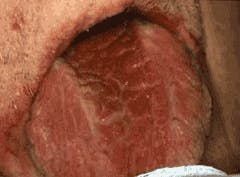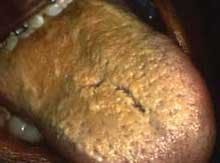Hairy Tongue
by Nancy W. Burkhart, RDH, EdD
[email protected]
Your patient is Alex Zimmerman, and a friend recommended your practice to him. He has been scheduled for a screening appointment, a prophylaxis, and radiographs. Generally, his health has been good but he has had recurring colds and bronchitis over the past year. Alex is a smoker and consumes alcohol daily.
During the past four months he was taking antibiotics for a skin infection after being diagnosed with MRSA (methicillin-resistant Staphylococcus aureus). He tells you that he is especially concerned about the appearance of his tongue. As you evaluate the tongue (see Figure 1), you notice the “hairy” appearance and the discoloration of the dorsal area of the tongue. You begin to remember what you thought you had forgotten about hairy tongue.
Courtesy of Dr. T.D. Rees
Etiology: The true etiology of hairy tongue is unknown. It is believed to be a reactive process and an alteration of microbial flora due to factors such as the use of antibiotics, smoking, alcohol use, the lowered immune response and general health of the person, radiation therapy for head and neck cancer, systemic corticosteroid therapy, and the use of certain products such as peroxide rinses (see Figure 2).
This slide depicts the variation in color of hairy tongue.Courtesy of Dr. Carolyn Bentley
Individuals who have compromised immune systems or chronic health issues are especially vulnerable. Some medications have been associated with the development of hairy tongue; however, a side effect of the medications also predisposes the person to xerostomia. In turn, the xerostomia may cause the perfect environment for the growth of candida.
Pathogenesis: The filiform papillae become elongated and discolored. This elongation gives the tongue the appearance of hair-like projections due to the hypertrophy of the papillae. The papillae have an increase in keratin and a possible decrease in keratin desquamation. The thicker, longer papillae allow food, beverages, bacteria, and any additional products used orally to become trapped in the papillae.
Hairy tongue and hairy leukoplakia should not be confused. Hairy leukoplakia occurs on the lateral border of the tongue as a white plaque, is caused by the Epstein-Barr virus, and is usually found in patients who are immunocompromised (a topic for an upcoming column).
The patient in this slide had severe xerostomia/candida and had long-term use of peroxide rinses. Originally, the papillae were elongated and eventually, a more “bald” appearance was evident. Courtesy of Dr. T.D. Rees
Perioral and intraoral characteristics: The elongated filiform papillae often harbor candida and have a colored appearance of black, brown, or yellow stain. The projections develop variable color states (see Figure 3). The patient may not complain of any pain or discomfort, but is usually concerned about the appearance of the tongue and the fear of malignancy. Often, the patient experiences taste alteration and complains of halitosis.
Prognosis and treatment: Candida may be a problem and often accompannies nies hairy tongue. Therefore, cytology assessment may be needed, followed by antifungal agents. Counseling the patient on proper brushing of the tongue, using a tongue scraper, discarding old, contaminated toothbrushes, treating any dentures or appliances for candida, along with carefully evaluating the general health of the patient, is the usual protocol.
This slide depicts the thick, elongated surface in the papillae of a patient with hairy tongue. Courtesy of Dr. T.D. Rees Edit this paragraph
Mouth rinses that contain alcohol promote xerostomia and should not be used. Patients may complain of an altered sense of taste and chronic halitosis that would need to be addressed. Sometimes the papillae can become so elongated that clipping with scissors may become necessary in order to allow antifungals or other medications to penetrate the thickness of the hairlike projections and speed the treatment that is necessary (see Figure 4).
References
DeLong L, Burkhart N. General and Oral Pathology for the Dental Hygienist. Lippincott Williams & Wilkins. Baltimore, 2008.
Eisen D, Lynch DP. The Mouth. Mosby St. Louis. 1998.
Regazi JA, Sciubba JJ, Jordan RCK, Oral Pathology: Clinical Pathologic Correlations. Saunders. St Louis, 2003.
Tamam L, Annagur BB. Black hairy tongue associated with olanzapine treatment: a case report. Mt. Sinai J Med. 2006 Oct;73(6):891-4.
Yuca K, Calka O, Kiroglu AF, Akdeniz N, Cankaya H. Hairy tongue: a case report. Acta Otorhinolaryngol Belg. 2004;58(4):161-3.
